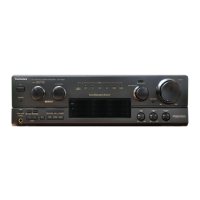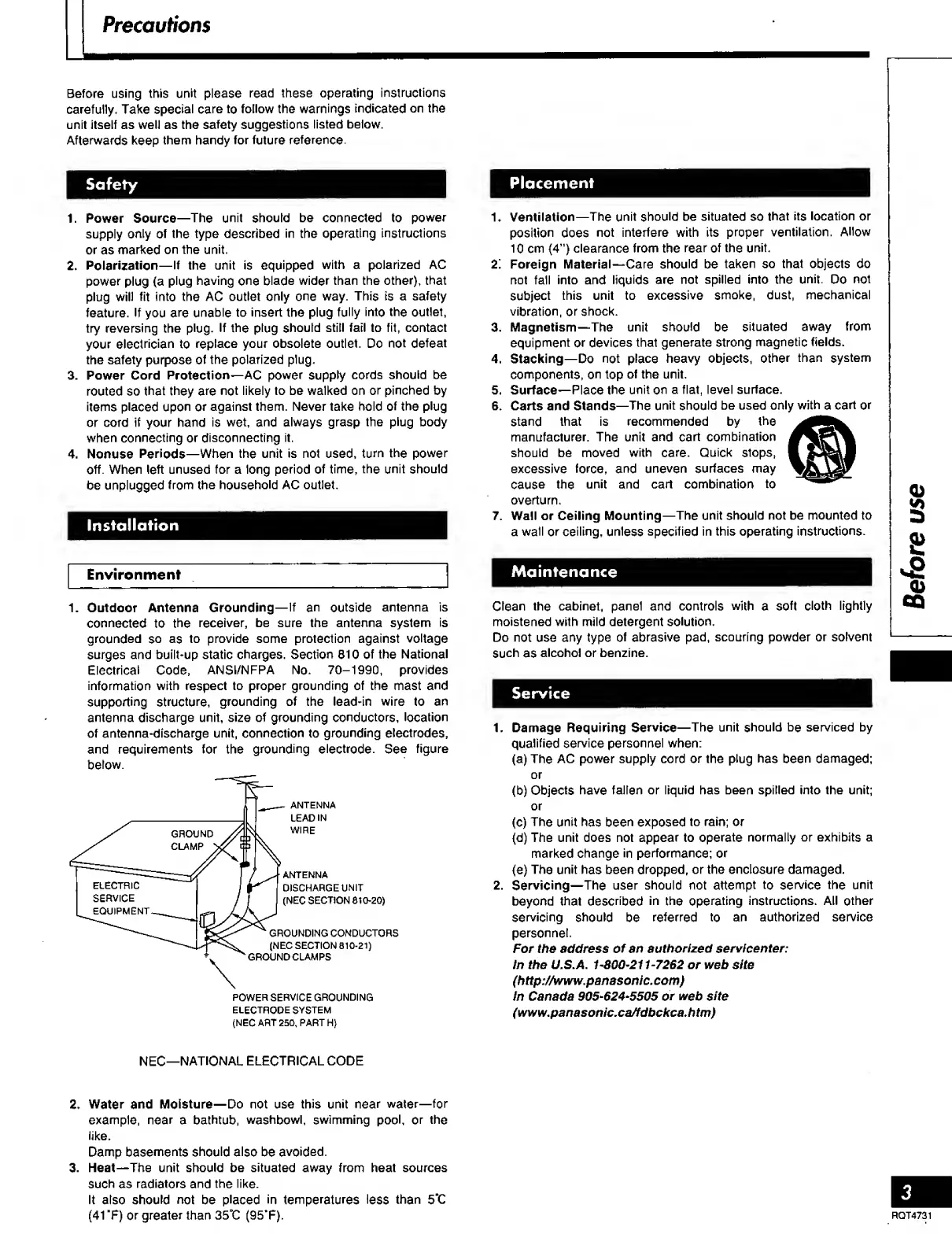Precautions
Before using this
unit
please
read these operating
instructions
carefully. Take
special care to
follow the
warnings indicated
on the
unit itself as well as the
safety suggestions
listed below.
Afterwards keep
them handy for future
reference.
Safety
1. Power Source
—
The
unit should be connected to
power
supply
only
of
the type described in the
operating
instructions
or as
marked on
the unit.
2.
Polarization
—If the unit is
equipped
with a polarized AC
power plug (a
plug
having
one
blade wider than the
other), that
plug
will
fit into the AC outlet only
one way.
This
is
a safety
feature.
If
you
are unable
to insert the plug
fully
into the outlet,
try reversing the
plug.
If
the plug
should still fail to fit, contact
your
electrician
to
replace your obsolete outlet. Do
not defeat
the safety purpose
of
the polarized plug.
3. Power Cord
Protection
—
AC
power supply
cords should be
routed so
that they are
not likely to be walked on
or pinched
by
items
placed upon or
against them. Never take hold
of the plug
or cord if your hand is
wet,
and always
grasp the plug body
when
connecting
or
disconnecting it.
4. Nonuse
Periods
—When the unit is not used,
turn the power
off. When left unused for a long period
of time,
the unit should
be unplugged
from the household AC outlet.
Installation
Environment
1. Outdoor Antenna
Grounding—
If
an outside
antenna is
connected
to
the
receiver, be sure the antenna system
is
grounded
so as
to provide some protection against
voltage
surges and built-up static charges.
Section 810 of
the National
Electrical
Code,
ANSI/NFPA
No.
70-1990, provides
information with respect to proper grounding of the mast
and
supporting structure,
grounding of the lead-in wire to
an
antenna discharge unit, size of grounding
conductors, location
of antenna-discharge unit,
connection
to
grounding
electrodes,
and requirements for the
grounding
electrode. See
figure
below.
POWER SERVICE
GROUNDING
ELECTRODE
SYSTEM
(NEC ART 250, PART H)
Placement
1.
Ventilation
—
The
unit should be situated so
that
its location
or
position
does
not interfere with its
proper
ventilation.
Allow
10 cm
(4")
clearance from the
rear of
the unit.
2'.
Foreign Material —Care
should
be
taken so that objects do
not fall into and
liquids are
not spilled into the
unit.
Do
not
subject
this unit to
excessive
smoke, dust, mechanical
vibration,
or
shock.
3.
Magnetism—The unit
should
be
situated away from
equipment or
devices that generate
strong
magnetic fields.
4. Stacking—Do
not
place
heavy objects,
other
than system
components, on top
of the unit.
5. Surface—Place
the
unit
on
a flat, level surface.
6. Carts and Stands
—
The
unit
should
be used only
with
a
cart or
stand
that
is
recommended by
the
^0^^
manufacturer. The unit
and cart
combination
M2k<P\%
should be
moved
with
care.
Quick stops, I
£"Tww
excessive
force, and uneven
surfaces may
^BL
afili
cause
the unit and cart combination to
overturn.
7. Wall or Ceiling
Mounting
—
The
unit
should
not be mounted to
a
wall or
ceiling,
unless specified
in this operating
instructions.
Maintenance
Clean
the cabinet, panel and controls
with
a
soft
cloth lightly
moistened with mild detergent
solution.
Do not use any type
of abrasive pad,
scouring powder or
solvent
such
as
alcohol or benzine.
Service
1. Damage Requiring
Service
—
The
unit should
be
serviced by
qualified service personnel
when:
(a) The AC power supply cord or the
plug has been damaged;
or
(b)
Objects have
fallen or liquid has been spilled into the unit;
or
(c)
The
unit has been exposed
to rain; or
(d) The unit does not
appear
to
operate
normally or exhibits a
marked change
in performance; or
(e)
The unit
has been
dropped, or the enclosure damaged.
2. Servicing—
The
user should not
attempt to service
the unit
beyond that
described
in
the
operating instructions. All other
servicing
should
be
referred to
an authorized service
personnel.
For the address
of
an
authorized
servicenter:
In the U.S.A.
1-800-211-7262
or web site
(http://www.panasonic.com)
In Canada
905-624-5505
or web site
(www.panasonic.ca/fdbckca.htm)
NEC—
NATIONAL ELECTRICAL CODE
2.
Water and
Moisture—Do not use this unit
near water—for
example,
near
a
bathtub, washbowl,
swimming
pool, or
the
like.
Damp
basements should also
be
avoided.
3. Heat —The unit should be situated away from heat sources
such
as
radiators and
the like.
It also
should not
be
placed in temperatures less
than 5*C
(41
"F)
or
greater than 35°C (95T).

